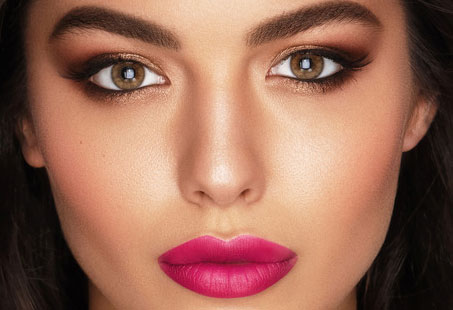Hooded eyes are one of many different eye shapes. It is usually characterised by the absence of a distinct crease in the upper eyelids. While many people confuse hooded eyes with droopy eyelids, they’re both different.
Hooded eyes are natural, and there’s nothing wrong with having them. However, some people have cosmetic issues with them and want to change the shape of their eyes by minimising the appearance of the “hood.”
What Are Hooded Eyes?
Hooded eyes are characterised by the presence of excess skin fold extending from the brow line to the lash line. The outer corners of the eyes are neither pulled up nor down, and there’s usually no visible crease in the upper eyelids. It can make the eyes look smaller.
Hooded eyes are not always a sign of ageing, but they can become more prominent with age. That’s because the skin around the eyes is thinner and is usually the first one to show the signs of ageing.
Here, it should be noted that even though the skin fold reaches the eyelashes in hooded eyes, it doesn’t really affect the vision. But hooded eyes can droop with age, which can obstruct the field of vision.
Since this eye shape can cause cosmetic concerns to some people, there are non-surgical and surgical ways to modify the position of the “hood” on top of the eyes. Some people also use glues and tapes to lift the eyelids upwards and outwards.
Hooded Eyes vs. Droopy Eyes
Excess sagginess or droopiness of the upper eyelids is referred to as ptosis. It is not the same as having hooded eyes. Ptosis or droopy eyes can happen due to the stretching of the muscle above the eyelids with age, nerve damage or some other medical condition. You may be born with ptosis if there is a problem with the muscles above the eyelids.
However, hooded eyes are not the result of a medical condition. If the edges of your eyelids are drooping, you may have difficulty seeing things, while this is not the case with hooded eyes.
Hooded eyes are also not the same as the condition known as dermatochalasis. In this, the skin hangs over the eyes because it has become loose and lax with age. This can also cause problems with the vision. So, the cause of the hooded eyes will determine the kind of treatment that’ll best suit you. And for that, you should consult a medical professional.
What Causes Hooded Eyes?
Hooded eyes can be a result of the following:
Genetics
Many people are born with hooded eyes because it is a hereditary trait. If people in your family have hooded eyes, you’re also likely to have them. It is something that can run in families.
Ageing
Hooded eyes can develop over time as a result of ageing. Skin loses elasticity which can make it hang downwards. In addition, the muscle tone changes, and they start to sag, which can result in the presence of a prominent hood over the eyes. It can make you look perpetually tired and old. You might also appear angry and serious. Gravity also makes the skin hang downward.
As far as signs of ageing are concerned, you should keep in mind that prolonged exposure to the sun, use of drugs, and smoking can speed up the process of ageing. So, you might end up with hooded eyes earlier than usual.
Trauma
The skin above your eyes can droop if a physical injury or accident has resulted in nerve damage in that area. When this happens, the muscles above the eyes are unable to hold their position, so they hang downwards, which compresses the tissue over the eyes. This will also give you hooded eyes.
Illness & Treatments
Hooded eyes can also be a sign of an underlying illness that causes brow ptosis. It can happen if you have a muscle disorder or infections like Ramsay Hunt, HIV, syphilis, Lyme or polio.
It could also be a result of spasms or cancer. Even cancer treatments like radiotherapy and chemotherapy can speed up the degeneration of the skin, which can give the eyes a hooded appearance.
How To Get Rid Of Hooded Eyes?
There are different surgical and non-surgical procedures that you can undergo to get rid of hooded eyes. These are as follows:
Botox
Botox is a very popular, non-surgical procedure to get rid of hooded eyes. Botulinum toxin is injected into the outer corners of the eyebrows, which stops the muscle from contracting and lifts the area. This helps make the eyes look bigger and less “hooded.”
It is important to find a qualified provider if you’re thinking about getting Botox for hooded eyes. That’s because if the Botox is injected into the wrong area, it can cause ptosis instead of lifting the eyes. Also, keep in mind that Botox only gives temporary results, so you’ll have to undergo the procedure after 6 months.
Dermal Fillers
If the reason why you have prominent hooded eyes is wrinkled, sagging skin, you can benefit from dermal fillers. Loss of volume makes the skin sag, but dermal fillers can fix that problem by restoring volume and tightening the skin. These hyaluronic acid injections can also stimulate the production of collagen.
Therefore, they can lift the skin in that area and smooth out the wrinkles, which can also help minimise the appearance of the hood over the eyes. This treatment also gives temporary results. Fillers can last from anywhere between 6 months to 2 years, after which you’ll have to get them again in order to maintain the results.
Laser Therapy
Another way to take care of hooded eyes due to loose, sagging skin is to undergo laser treatment. It will remove the top layer of the skin and promote the production of collagen in the skin, which will tighten and lift it. It will also make the area appear smoother and less wrinkly. Keep in mind that it would work best for mild cases. A laser will not give dramatic results if the ptosis is severe.
Thread Lift
Thread lift is a minimally invasive cosmetic procedure in which sutures or “threads” are used to lift and pull back the eyebrows. The skin is essentially stitched up. The procedure will only give you temporary results.
Also, keep in mind that it’s not the same as a facelift, in which the excess skin is cut out. Thread lift is more suitable for those who only have a mild problem. However, if there’s excess hanging skin, a surgical facelift can give better results as a thread lift will only move the eyebrows up by a few millimetres.
Blepharoplasty
Blepharoplasty or eyelid surgery is an invasive procedure that can be done for functional and cosmetic reasons. The surgeon will remove excess skin from the upper eyelid, tighten the muscles underneath, and remove fat.
Older patients with severe skin sagging and impaired vision may benefit more from this procedure. The incisions in this surgery are made along the natural crease, so it’s not visible. And it should fade with time. Only this procedure can permanently change the shape of your hooded eyes.
How To Minimise the Appearance of Hooded Eyes?
As mentioned above, ageing can make the hooded eyes more prominent. So, there are a few things that you can do to minimise the hood.
- Wear Sun Protection – Avoid prolonged sun exposure, wear sunscreen and protect yourself with hats and umbrellas.
- Avoid Using Tobacco Products & Drugs – Quit smoking and do not use recreational drugs as they can speed up the ageing process.
- Keep Skin Hydrated – Make sure to keep the skin around the eyes moisturised and hydrated.
- Exercise – Consider trying out some droopy eyelid exercises to increase muscle strength and tone them up (it has no scientific evidence, and you should be careful when doing them).
- Try Makeup – Those who have hooded eyes can use makeup to make their eyes look bigger. For instance, they can do so by using mascara to make their eyelashes more voluminous. Many create a fake crease and do cut crease as the contrasting eyeshadows make the eyes look bigger. Winged eyeliner is also quite popularly done to make the hooded eyes look lifted. Waterproof products are important so that the makeup doesn’t get smudged.
Doing these things may help prevent the hooded area of the eyes from becoming more prominent. While makeup can temporarily hide it, it’s important that you take care of the skin underneath.
Conclusion
The development of hooded eyes may be inherited, the result of ageing, or the result of an underlying health problem. The treatment can vary depending on the that. However, if it’s genetic or due to ageing, you can benefit from different cosmetic procedures. It is important that you consult a dermatologist for an accurate diagnosis. And they’ll also provide you with a treatment plan accordingly.

